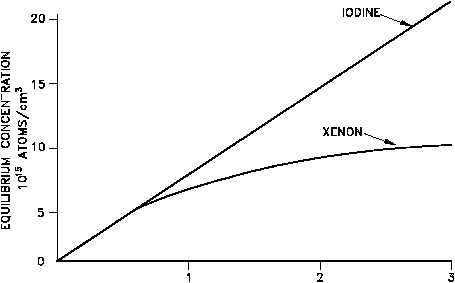NXe (eq)
Xe
I
fuel
f
Xe
Xe
a
Xe
a
Reactor Theory (Nuclear Parameters)
DOE-HDBK-1019/2-93
XENON
NP-03
Page 37
Rev. 0
Figure 4 Equilibrium Iodine-135 and Xenon-135 Concentrations Versus Neutron Flux
For xenon-135 to be in equilibrium, iodine-135 must also be in equilibrium. Substituting the
expression for equilibrium iodine-135 concentration into the equation for equilibrium xenon
results in the following.
From this equation it can be seen that the equilibrium value for xenon-135 increases as power
increases, because the numerator is proportional to the fission reaction rate. Thermal flux is also
in the denominator; therefore, as the thermal flux exceeds 10 neutrons/cm -sec, the
term
12
2
begins to dominate, and at approximately 10 neutrons/cm -sec, the xenon-135 concentration
15
2
approaches a limiting value. The equilibrium iodine-135 and xenon-135 concentrations as a
function of neutron flux are illustrated in Figure 4.
The higher the power level, or flux, the higher the equilibrium xenon-135 concentration, but
equilibrium xenon-135 is not directly proportional to power level. For example, equilibrium
xenon-135 at 25% power is more than half the value for equilibrium xenon-135 at 100% power
for many reactors. Because the xenon-135 concentration directly affects the reactivity level in
the reactor core, the negative reactivity due to the xenon concentrations for different power
levels or conditions are frequently plotted instead of the xenon concentration.

